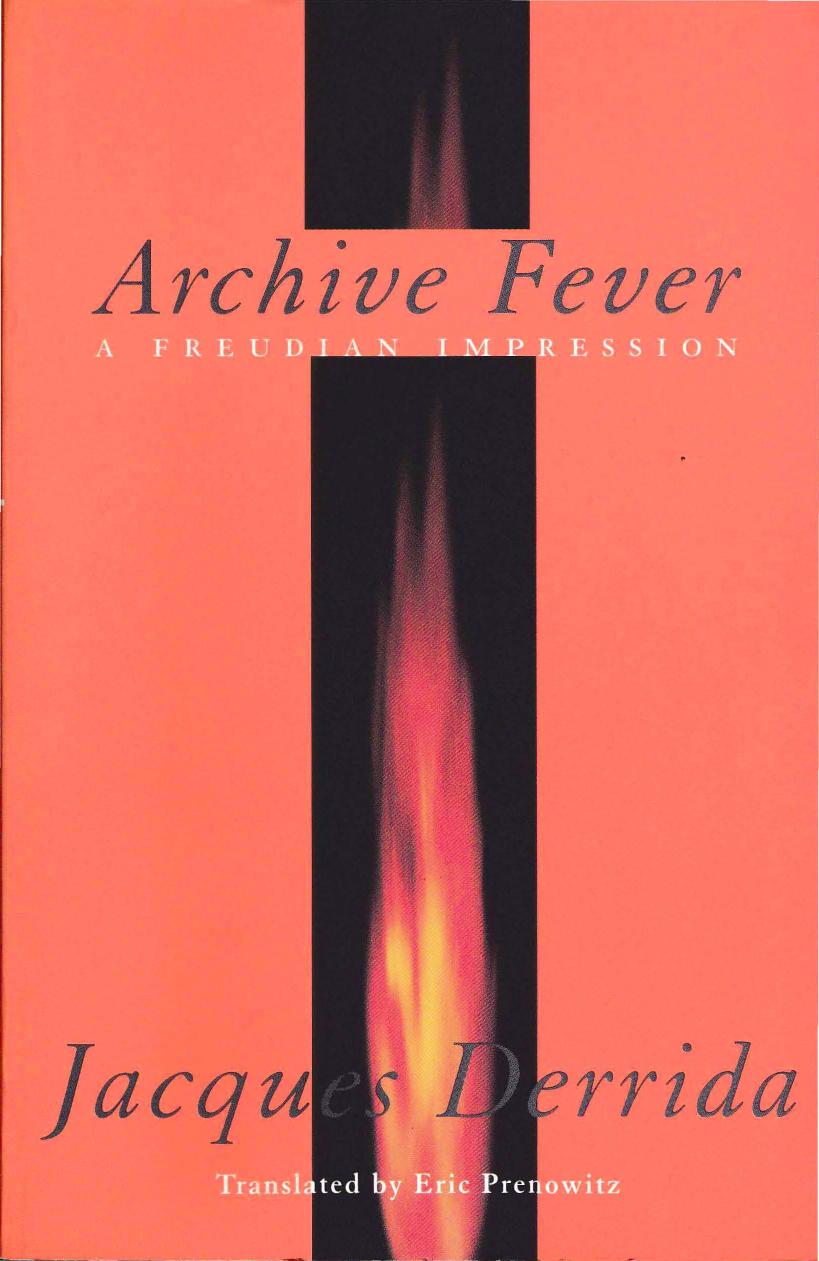Jacques Derrida: Archive Fever: A Freudian Impression (1996)
Filed under book | Tags: · archive, philosophy, psychoanalysis, technology, time

“In Archive Fever, Jacques Derrida deftly guides us through an extended meditation on remembrance, religion, time, and technology—fruitfully occasioned by a deconstructive analysis of the notion of archiving. Intrigued by the evocative relationship between technologies of inscription and psychic processes, Derrida offers for the first time a major statement on the pervasive impact of electronic media, particularly e-mail, which threaten to transform the entire public and private space of humanity. Plying this rich material with characteristic virtuosity, Derrida constructs a synergistic reading of archives and archiving, both provocative and compelling.”
Translated by Eric Prenowitz
Publisher University of Chicago Press, 1996
ISBN 0226143368, 9780226143361
113 pages
PDF (updated on 2021-11-11)
PDF (article, published in Diacritics, 25:2, Summer, 1995, pp 9-63, added on 2012-9-3)
Charles Merewether (ed.): The Archive (2006)
Filed under book | Tags: · archive, archiving, art, art history, history, identity, memory, museum, theory

“In the modern era, the archive—official or personal—has become the most significant means by which historical knowledge and memory are collected, stored, and recovered. The archive has thus emerged as a key site of inquiry in such fields as anthropology, critical theory, history, and, especially, recent art. Traces and testimonies of such events as World War II and ensuing conflicts, the emergence of the postcolonial era, and the fall of communism have each provoked a reconsideration of the authority given the archive—no longer viewed as a neutral, transparent site of record but as a contested subject and medium in itself.
This volume surveys the full diversity of our transformed theoretical and critical notions of the archive—as idea and as physical presence—from Freud’s “mystic writing pad” to Derrida’s “archive fever”; from Christian Boltanski’s first autobiographical explorations of archival material in the 1960s to the practice of artists as various as Susan Hiller, Ilya Kabakov, Thomas Hirshhorn, Renée Green, and The Atlas Group in the present.”
Publisher Whitechapel, London, and MIT Press, 2006
Documents of Contemporary Art series
ISBN 0262633388, 9780262633383
207 pages
Reviews: Sas Mays (caa.reviews 2009), Barbara Beckers (Incirculation 2012).
PDF (13 MB, updated on 2016-8-8)
Comments (8)Seth Kim-Cohen: In the Blink of an Ear: Toward a Non-Cochlear Sonic Art (2009)
Filed under book | Tags: · art, art history, music, music history, musique concrète, ontology, phenomenology, rock'n'roll, sculpture, sound, sound art

“An ear-opening reassessment of sonic art from World War II to the present.
Marcel Duchamp famously championed a “non-retinal” visual art, rejecting judgments of taste and beauty. In the Blink of an Ear is the first book to ask why the sonic arts did not experience a parallel turn toward a non-cochlear sonic art, imagined as both a response and a complement to Duchamp’s conceptualism. Rather than treat sound art as an artistic practice unto itself—or as the unwanted child of music—artist and theorist Seth Kim-Cohen relates the post-War sonic arts to contemporaneous movements in the gallery arts. Applying key ideas from poststructuralism, deconstruction, and art history, In the Blink of an Ear suggests that the sonic arts have been subject to the same cultural pressures that have shaped minimalism, conceptualism, appropriation, and relational aesthetics. Sonic practice and theory have downplayed – or, in many cases, completely rejected – the de-formalization of the artwork and its simultaneous animation in the conceptual realm.
Starting in 1948, the simultaneous examples of John Cage and Pierre Schaeffer initiated a sonic theory-in-practice, fusing clement Greenberg’s media-specificity with a phenomenological emphasis on perception. Subsequently, the “sound-in-itself” tendency has become the dominant paradigm for the production and reception of sound art. Engaged with critical texts by Jacques Derrida, Rosalind Krauss, Friedrich Kittler, Jean François Lyotard, and Jacques Attali, among others, Seth Kim-Cohen convincingly argues for a reassessment of the short history of sound art, rejecting sound-in-itself in favor of a reading of sound’s expanded situation and its uncontainable textuality. At the same time, this important book establishes the principles for a nascent non-cochlear sonic practice, embracing the inevitable interaction of sound with the social, the linguistic, the philosophical, the political, and the technological.
Artists discussed include: George Brecht, John Cage, Janet Cardiff, Marcel Duchamp, Bob Dylan, Valie Export, Luc Ferrari, Jarrod Fowler, Jacob Kirkegaard, Alvin Lucier, Robert Morris, Muddy Waters, John Oswald, Marina Rosenfeld, Pierre Schaeffer, Stephen Vitiello, La Monte Young.”
Publisher Continuum, New York/London, 2009
ISBN 082642970X, 9780826429704
296 pages
Reviews: Laura Paolini (MusicWorks, 2010), Will Scrimshaw (2010), Brian Kane (NonSite, 2013).
PDF (updated on 2020-7-13)
Comments (5)
